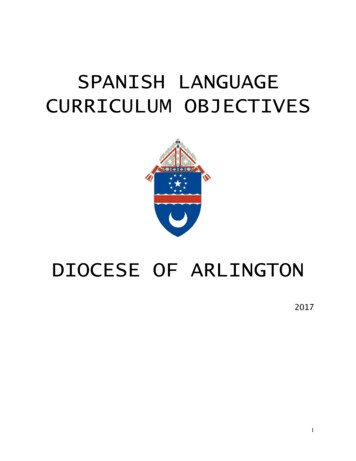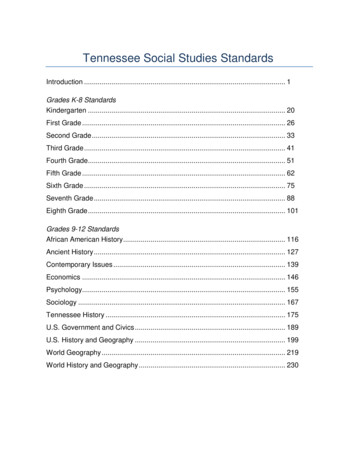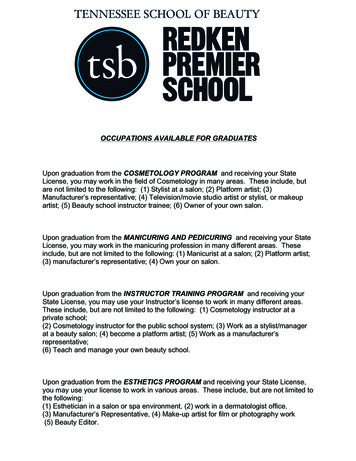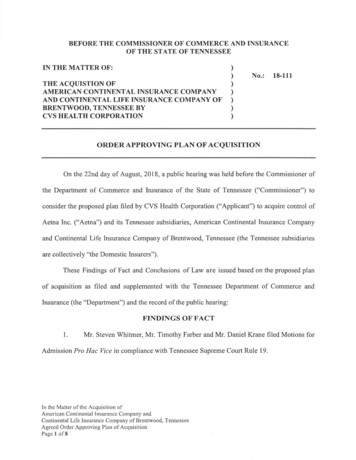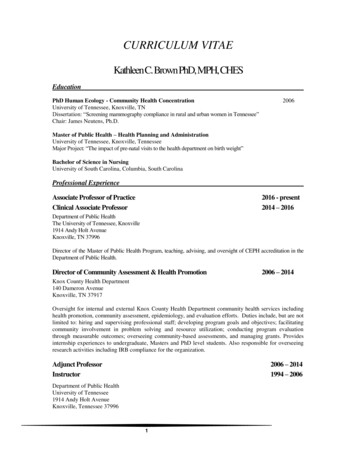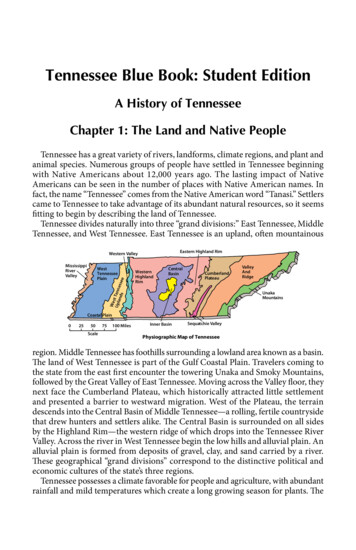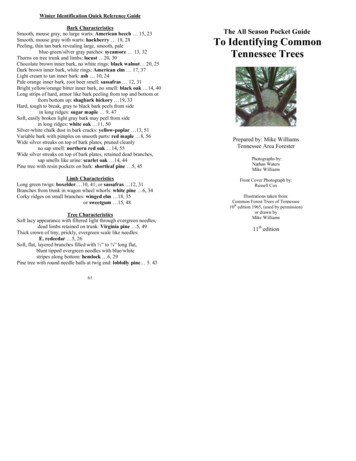
Transcription
Winter Identification Quick Reference GuideBark CharacteristicsSmooth, mouse gray, no large warts: American beech 15, 23Smooth, mouse gray with warts: hackberry 18, 28Peeling, thin tan bark revealing large, smooth, paleblue-green/silver gray patches: sycamore 13, 32Thorns on tree trunk and limbs: locust 20, 30Chocolate brown inner bark, no white rings: black walnut 20, 25Dark brown inner bark, white rings: American elm 17, 37Light cream to tan inner bark: ash 10, 24Pale orange inner bark, root beer smell: sassafras 12, 31Bright yellow/orange bitter inner bark, no smell: black oak 14, 40Long strips of hard, armor like bark peeling from top and bottom orfrom bottom up: shagbark hickory 19, 33Hard, tough to break, gray to black bark peels from sidein long ridges: sugar maple 9, 47Soft, easily broken light gray bark may peel from sidein long ridges: white oak 11, 50Silver-white chalk dust in bark cracks: yellow-poplar 13, 51Variable bark with pimples on smooth parts: red maple 8, 56Wide silver streaks on top of bark plates, pruned cleanlyno sap smell: northern red oak 14, 55Wide silver streaks on top of bark plates, retained dead branches,sap smells like urine: scarlet oak 14, 44Pine tree with resin pockets on bark: shortleaf pine 5, 45Limb CharacteristicsLong green twigs: boxelder 10, 41; or sassafras 12, 31Branches from trunk in wagon wheel whorls: white pine 6, 34Corky ridges on small branches: winged elm 18, 35or sweetgum 15, 48Tree CharacteristicsSoft lacy appearance with filtered light through evergreen needles,dead limbs retained on trunk: Virginia pine 5, 49Thick crown of tiny, prickly, evergreen scale like needles:E. redcedar 5, 26Soft, flat, layered branches filled with ½” to ¾” long flat,blunt tipped evergreen needles with blue/whitestripes along bottom: hemlock 6, 29Pine tree with round needle balls at twig end: loblolly pine 5. 4361The All Season Pocket GuideTo Identifying CommonTennessee TreesPrepared by: Mike WilliamsTennessee Area ForesterPhotographs by:Nathan WatersMike WilliamsFront Cover Photograph by:Russell CoxIllustrations taken from:Common Forest Trees of Tennessee10th edition 1965, (used by permission)or drawn byMike Williams11th edition
PREFACEThis booklet was prepared by professional foresters to helpyou identify Tennessee’s most common trees. It is designed togo to the woods with you (where it is needed) by comfortablyriding in your back pocket, pack, or cruiser’s jacket. Enjoy!USEFUL TIPS1.2.3.4.5.6.7.8.Get ready for variability! Tree leaves may vary insize on the same tree. Leaves growing in the shadeare often much larger than leaves exposed to full sun.Some trees may have more than one leaf shapegrowing on the same tree.Learn bark characteristics and tree shape as quicklyas possible. Leaves are not present on many trees atleast half of the year.Tree bark is oldest, thickest and roughest at the baseof the tree trunk and youngest, thinnest andsmoothest on the branch tips. There is usually a slowtransition in bark pattern and thickness between thetwo points.Use all of your senses. Some trees may have aunique smell, taste or feel that helps in identificationIf necessary, supplemental identification clues can begathered from the leaves, twigs and fruit lying on theground under the tree. Always remember that theseitems may have come from a neighboring tree.To identify trees not listed in this book, collect orphotograph samples that include several leaves andbuds then go to the internet or other ID books tomake the identification. State, University and USDAForest Service web pages are usually the best internettree identification sites.Relax and have fun. Even the best professionalforesters occasionally have trouble identifying trees.iNotes.60
Common and Scientific NamesFor Trees Listed In This BookletINDEXSUBJECTOak (Quercus)Black oak (Quercus velutina) 14, 40Blackjack oak (Quercus marilandica) 14Cherrybark oak (Quercus falcata) 14Chestnut oak (Quercus prinus) 11, 42Chinquapin oak (Quercus muehlenbergii) 11Northern red oak (Quercus rubra L) 14, 55Nuttall oak (Quercus nuttallii) 14Overcup oak (Quercus lyrata) 11Pin oak Quercus palustris) 14Post oak (Quercus stellata) 11Scarlet oak (Quercus coccinea) 14, 44Southern red oak (Quercus falcata) 14, 57Shumard oak (Quercus shumardii) 14Swamp chestnut oak (Quercus michauxii) 11Swamp white oak (Quercus bicolor) 11Water oak (Quercus nigra L) 14White oak (Quercus alba L.) 11, 50Willow oak (Quercus phellos L.) 14Pine (Pinus)Loblolly pine (Pinus taeda L.) 5, 43Shortleaf pine (Pinus echinata) 5, 45Virginia pine (Pinus virginiana) 5, 49White pine (Pinus strobus L.) 6, 34Red mulberry (Morus rubra) 12Sassafras (Sassafras albidum) 12, 31Sourwood (Oxydendrum arboreum) 19, 46Sweetgum (Liquidambar styraciflua) 15, 48Sycamore (Platanus occidentalis) 13, 32Yellow-poplar (Liriodendron tulipifera) .13, 5159Poison ivy alert 1Tennessee terrain 2Trees on flat, well-drained land 2Trees in swampy areas & along streams 2Trees in deep, well-drained coves 3Trees on dry, south facing slopes 3Trees on dry ridge tops 3Summer leaf key definitions 4Summer leaf key 5-20Identifying trees without leaves 21Easy to identify trees 22-35Trees of medium difficulty 36-51Trees that require close examination 52-57Common and scientific names 58-59Notes 60Winter quick reference guide 61ii
Poison Ivy AlertPOISON IVY Poison ivy is a common forest vine thatgrows along the ground and often climbs trees. When itclimbs a tree it sometimes becomes so large and thick itcan be misidentified as being part of the tree it isattached to. Climbing poison ivy vines are dark brown,very “hairy” looking, and closely attached to thesupporting tree. The many closely spaced branches ofthe vine may reach out 3’ or more from the tree. Thevine may climb 20’ or more up the tree. Poison ivyleaves are attached to branch ends in clusters of 3leaflets. Leaflets average 3” to 5” long, 2” to 4” wide.They may be entire, have a tooth shaped lobe on oneside, or have one tooth shaped lobe on each side.foliagevineContact with almost any part of the plant any time ofyear can cause the skin to break out in a severe, itchyrash. Avoidance is the best protection.Virginia creeper is also a common vine that climbsforest trees but human contact does not normally cause arash. Virginia creeper has five leaflet cluster leaves, isoften wrongly called poison oak, and is harmless.1Common and Scientific NamesFor Trees Listed in this Booklet.American beech (Fagus grandifolia) 15, 23Ash (Fraxinus)Green ash (Fraxinus pennsylvanica) 10, 24White ash (Fraxinus americana) 10, 24Bald cyprus (Taxodium distichum L.) 6, 38Black cherry (Prunus serotina) 16, 39Blackgum (Nyssa sylvatica Marsh) 16, 53Black walnut (Juglans nigra L.) 20, 25Boxelder (Acer negundo L.) 10, 41Eastern red cedar (Juniperus virginiana L.) 5, 26Elm (Ulmus) 17, 18American elm (Ulmus americana) 17, 37Slippery elm (Ulmus rubra) 17Winged elm (Ulmus alata) 18, 35Flowering dogwood (Cornus florida) 8, 27Hackberry (Celtis occidentalis) 18, 28Hemlock (Tsuga)Eastern hemlock (Tsuga canadensis) 6, 29Carolina hemlock (Tsuga caroliniana) 6, 29Hickory (Carya)Bitternut (Carya cordiformis) 19, 54Mockernut (Carya tomentosa) 19, 54Pignut (Carya glabra) 19, 54Shagbark hickory (Carya ovata) 19, 33LocustBlack locust (Robinia pseudoacacia) 20, 30Honey locust (Gleditsia triacanthos) 20, 30Maple (Acer) 8Red maple (Acer rubrum) 8, 56Silver maple (Acer saccharinum) 9Sugar maple (Acer saccharum) 9, 4758
Trees that Require Close Examination – s. red oakSOUTHERN RED OAK- Southern red oak is one ofTennessee’s most common trees. It usually has a round,well pruned trunk with a slight swell at the base andgood form up to strong, well spaced limbs at the top.The bark is very rough but thin (less than ⅜” thick)giving the illusion of its being compressed and gluedto the tree. This bark is hard, cool to touch, and roughtextured. Bark patterns vary from long, rough toppedridges and shallow valleys to clusters of plastered wetcorn flakes. Bark color varies from light gray to black.Lichens growing on the bark often give the tree agreenish look. The inner bark is various shades ofbrown, sometimes with cream colored short, fine linesand flecks present.trunkupward viewbarkleavesTennessee TerrainTrees prefer to grow in places that suit theirparticular needs. Most like the deep, well drained soilsof flat to easy rolling land. But, some want wet placeslike swamps or bottoms; some moist, well-drainedcoves, hollows or north facing slopes. Some prefer hot,dry ridge tops and warmer, south facing slopes.Knowing which trees are most likely to be encounteredin different parts of Tennessee and on given sites canhelp narrow down likely tree choices and speed upproper identification. Check the following guides to findthe trees most likely to be encountered on any given sitein Tennessee.Trees Likely to be Found Growing onFlat, Well Drained Landashblack oakelmhickorysassafrassour-woodVirginia pineyellow-poplarbeechblack walnutflowering dogwoodlocustscarlet oaksouthern red oakwhite oakblack cherryblackgumhackberryred mapleshort leaf pinesugar maplewhite pineTrees Likely to be Found Growingin Swampy Areas and Along Streams:Mature leaves are usually 5” to 7” long and dark green.The long central lobe and two shorter opposite side lobesoften give leaf a “turkey foot” look. Leaves may alsohave smaller additional side lobes. All lobes are bristletipped.57ashboxeldermulberrypin oaksilver maplesweetgumwillow oakbaldcypresscherrybark oaknuttall oakred mapleswamp chestnut oaksycamoreyellow-poplar2beechhemlockovercup oakshumard oakswamp white oakwater oak
Trees Likely to be Found Growing inDeep, Well-Drained Covesashblack oakchinquapin oakhickoryscarlet oaksouthern red oakwhite pinebeechblack walnutelmnorthern red oakshortleaf pinesugar mapleyellow-poplarblack cherryblackgumhemlockred mapleshumard oakwhite oakTrees Likely to be Found Growing onDry South Facing Middle Slopesashblackjack oakeastern redcedarlocustscarlet oaksouthern red oakblack oakchestnut oakhickorypost oakshortleaf pineVirginia pineblackgumchinquapin oakloblolly pinered maplesour-woodwhite oakTrees that Require Close Examination – red mapleRED MAPLE – Red maple is a challenge to identifybecause of the way it changes characteristics as it getslarger. This tree has slick, light gray bark when it issmall. As it gets larger it develops a thicker, grayishbrown, flaky bark that is heaviest at the base andbecomes smoother up the trunk. Full grown trees mayhave flaky bark all the way up into the limbs. While thisbark is in transition and smooth patches of bark are stillpresent, very small pimples can usually be foundscattered over the smooth surface. The crotch betweentrunk and limbs on red maple is usually narrow. Slenderyoung branch tips are often bright red.bark characteristicstwig, leaf, fruitTrees Likely to be Found Growing onDry Ridge Topsashchestnut oakloblolly pinescarlet oakVirginia pineblack oakeastern redcedarpost oakshortleaf pineblackjack oakhickoryred maplesouthern red oakLeaves are 2½” to 4” in length and width with wide butjagged edges along the lobes. Usually there are threelarge lobes and sometimes two smaller ones. Thesinuses between each lobe form a sharp V notch.356
Trees that Require Close Examination – n. red oakNORTHERN RED OAK – Northern red oak oftengrows to be a very large, cleanly pruned tree. It hasstrong, well spread limbs and dark gray bark that haslong cracks or fissures running up and down the treebetween long, wide slightly concave plates of bark.Looking up into the tree will usually reveal long, widesilver streaks along the tops of the bark plates on thetrunk and major branches. Northern red oak can beconfused with scarlet oak but northern red oak is usuallya larger, well pruned, better formed tree. The northernred oak sap does not smell like urine.barkleafupward viewSummer Leaf KeyDefinitions needed to understand Tree keyThe following terms need to be understood tosuccessfully understand and use the following tree guide.1. Opposite growth pattern Twigs and/or leaves areattached to the limb directly across from oneanother.2. Alternate growth pattern twigs and/or leaves areattached to the limb in a zigzag pattern where theattachments on either side are not directly acrossfrom one another.3. Simple leaf A leaf that has only one leafletattached to the tree limb.4. Compound leaf A leaf that has two or moreleaflets attached to a central leaf stem that is in turnattached to the tree limb.5. Leaf lobe The portion of the leaf that projects outfrom the central leaf like a finger on a hand.6. Lobe spikes Needle like point sticking out at theend of each lobe7. Leaf sinus The dip in the leaf between the lobes.8. Toothed margin Coarse to fine serrated edges.Leaves are simple, alternate, 5” to 9” long and 3” to 5”wide, broader toward the tip, divided into 7 to 9 lobes,each lobe being somewhat coarsely toothed, bristletipped and firm, dull green above, paler below, oftenturning a brilliant red after frost.554
Leaf Key to TreesCommon in TennesseeLeaves are needle-like or scale-likeLeaves are broad, flat and mostly deciduousTrees that Require Close Examination hickory(go to 1)(go to 2)1Needle Like or Scale Like Leaveseastern redcedar, southern yellow pines,white pine, hemlocks, bald cypress1a - Very small blue-green scale like leaves growingon all four sides in tight aromatic prickly top.eastern redcedar (page 26)HICKORY – The tight barked members of the hickorygroup can be very difficult to recognize in the winter.Distinguishing characteristics include tight, gray bark,ranging from tight and “glued on” criss-crossed barkXX furrows to a rougher bark that makes long,rough ridges and valleys up and down the tree. Theridges often crack into sections with cross cracksrunning horizontal to the tree. The bark is very toughand often feels like steel armor. There may be asplattering of small silver flecks scattered up anddown the bark. Smaller trees in the understory willhave short limbs growing at right angles to the treetrunk. Taller trees still competing in the overstory forlight may have limbs that fork upward with longer,stronger limbs. Branch ends are short and wavy.tree bark fruit, leaves, twigsbark1b - Needles growing in bundles with 2 to 3 needlesin each bundle.southern yellow pines (pages 43, 45, 49)loblolly pineshortleaf pineVirginia pine5Leaves have alternate arrangement with compoundleaves. The leaf is 8” to 14” long with from 5 to 9 finetoothed leaflets that are usually yellow green on top andpaler on the bottom. Leaflets come off a central leafstem at intervals along the side and off the end of thestem.54
Trees that Require Close Examination blackgumBLACKGUM Blackgum looks like an oak tree thathad a bad hair day! The silver gray to almost black barkof larger black gums often so closely resembles oak orelm that at first glance the tree may be misidentified.Looking up will reveal a crown filled with unusuallysmall, relatively short, often twisted branchesgrowing out of the tree trunk at 90ْ angles. The lowerbranches of younger trees will often droop dramatically,especially if the tree is exposed to enough sunlight toencourage side growth.leavestree trunkThe leaves are simple; 2” to 5” long and 1½” to 3” wide.The edges are almost always smooth. Shape varies frombroadly oval to narrow at the base, gently flaring out to amaximum width at a point approximately ⅔ of the waytoward the end of the leaf, then rounding down to the tipon the end of the leaf. Most leaves have a short, narrow,protruding tip on the end. Healthy leaves are a deep,dark, lustrous, green color.531c - Soft, flexible, blue-green needles, 3 to 5 incheslong and growing in bundles of 5. Each needlehas white lines along the length of the bottomedge. Dark gray-black bark; limbs growing fromtrunk at distinct intervals in whorls.eastern white pine (page 34)1d - Flat needles are ½” to ¾” long with blunt ends.Two parallel pale blue lines often present, alongthe bottom of each leaf. Needles lay flat (eastern).Needles stick out in all directions (Carolina).hemlocks (page 29)eastern hemlockCarolina hemlock1e - Needles are lime green to yellow-green, ½” to ¾”long, growing feather like in two rows along lateralbranches. Needles stand on small pegs. Needlesturn dull red and fall off in fall leaving stubby pegs.baldcypress (page 38)6
2Leaves That Are Broad and Flat2a. Leaves, buds, and branches that have oppositearrangement with simple leaves (go to A)TREES THAT REQUIRE CLOSE EXAMINATIONBlackgum 53Hickory (other than shagbark) 54Northern red oak 55Red maple 56Southern red oak 572b. Leaves, buds, and branches that have oppositearrangement with compound leaves (go to B).2c. Leaves, buds, and branches that have alternatearrangement with simple leaves (go to C).2d. Leaves, buds, and branches that have alternatearrangements with compound leaves (go to D).752
Trees of Medium Difficulty – yellow-poplarYELLOW-POPLAR – Yellow-poplar (tulip-poplar) isa distinctive tree that grows straight and round. Thebark is smooth and mouse gray in small trees, becomingrougher and more butternut brown as the tree growslarger. On all but the largest trees, the bark usuallylooks more like it was molded on the tree than split andcracked away as the tree grew. The singlecharacteristic that makes identification relativelyeasy is the presence of what looks like white to silverwhite chalk dust inside the channels and depressionsof the bark. This silver white dusting is consistent frombottom to top of the tree. Further identifyingcharacteristics include clean, pruned trunks that may bevery tall with a relatively small top, the tendency togrow in pure stands, and leftover seed-pods that looklike small, peeled bananas standing upright on the endsof the upper branches.AOpposite Arrangement- Simple Leavesflowering dogwood, red maple,sugar maple, silver mapleA-1 Dark green leaves are football shaped, 3” to 5”long and 2” to 3” wide with smooth but wavyouter edges. The veins make pronouncedsweeping upward curves from the center line ofthe leaf to the outside edge.flowering dogwood (page 27)A-2 Smooth leaves are 2½” to 4” in length andwidth with wide but jagged edges along the lobes.Usually there are three large lobes andsometimes two smaller ones. The sinusesbetween each lobe forms a sharp V notch.red maple (page 56)518
A-3 Smooth leaves are 3” to 5” long and wide withsmooth edges along five main lobes that havepointed tips. Deep U shaped sinuses between lobes.sugar maple (page 47)Trees of Medium Difficulty white oakWHITE OAK – White oak has one of the lightestcolored barks in Tennessee’s forests. It typically is verylight gray with a texture that varies from mediumrough and tight bark to long strips cracking looseand peeling from the side. The bark feels soft to thetouch, warm, and crumbles off the tree when rubbed.Sections of bark that are peeling loose from the side canbe easily broken off (unlike shagbark hickory that peelsfrom the top and bottom and resists breakage). Whiteoaks are often among the largest trees in the forest.They have large, strong, well-spaced branches.barkupward viewA-4 Leaves are 5” to 7” long and, deeply lobed,with large marginal teeth, silvery beneath.silver mapleThe leaves are 5” to 9” long and about half as broad.They are deeply divided into 5 to 9 rounded, finger-likelobes with no spikes. Mature leaves are bright greenabove and much paler below.950
Trees of Medium Difficulty – Virginia pinesVIRGINIA PINE (a southern yellow pine) Virginiapines usually grow up together as a pure stand butsometimes grow mixed with shortleaf and other pines.The distinguishing characteristics include Thin, brown,flaky bark, usually complete with dead stubs up anddown the trunk. The 2 needles per bundle tree crownis fairly thin and uniform throughout the crown insteadof the usual heavy clumps of greenery between openspaces seen in most southern yellow pines. Looking upthrough the tree’s canopy presents the overall effectof a consistently thin, soft, lacy, filtered light. Thecones or burrs average about 2” in length. They arenarrow and often slightly curved, with small prickles.treesbarkBOpposite Arrangement- Compound Leavesash, boxelderB-1 8” to 12” leaves have 3 to 7, 1½” long leafletsgrowing along the sides and end of the leaf stalk.Twigs ends look large and blunt. Green ash has aprominent bud nestled in the crotch between the twigand leaf. White ash has a small bud that is buried inthe crotch and not readily visible to the naked eye.green ashwhite ash(page 24)upward viewB-2 Leaves are 8” to 12” long and have 2” to 4” leafletsthat have several shapes with some jutting out to theside like pointed thumbs. Twigs are long, slenderand often green.boxelder (boxwood) page 41The twisted and spreading needles are borne two in acluster. They vary from 1½” to 3” in length, are yellowgreen in color, and are shorter than those of any otherpine native to the State.4910
C.Alternate Arrangement- Simple LeavesLeaves have rounded lobes(go to C-1)Leaves have pointed lobes(go to C-2)Leaves have no lobes(go to C-3)C-1Leaves have rounded lobeswhite oaks, sassafrasC-1a Leaves are tough, varying in size and shape butAlmost always have the same number of blunt teethor rounded lobes on each side of the leaf. Theoutside edge of the leaf is smooth with the main leafvein ending at the center of the center tooth or leaflobe while veins to the other teeth or lobes come offdifferent places along the central vein.white oaks (pages 50, 42)white oakTrees of Medium Difficulty – sweetgumSWEETGUM – Sweetgum has a light gray, rough corklike bark. It is tall, with a narrow “tee pee” shaped top.Many of the limbs may have one or more corky ridgesgrowing along their lengths. The fruit capsules areusually about the size of a golf ball and look likestarbursts on a stem because they have sharp open pointspointing in all directionsbarktreeupland white oakschinquapin oak post oak chestnut oakleafovercup oak swamp white oak swamp chestnut oaklowland white oaks11fruittwigThe simple, alternate star-shaped leaf, with its 5 to 7points or lobes, is 5” to 7” across and very aromatic. Inthe fall its coloring is brilliant, ranging from pale yellowthrough orange and red to a deep bronze.48
Trees of Medium Difficulty – sugar mapleSUGAR MAPLE – Sugar maple can often be identifiedby the often present, solid black, burned lookingareas on the lower parts of the tree trunk and/or thelong strips of tight, side curling bark that is verytough and hard to break off. Young trees are smoothand gray but as the tree gets larger, the bark begins toturn black at the base and begins to split and curl fromthe side. Even when it is curling, the bark remains verytough and hard to break off. Sugar maples grown inthe woods usually have lower limbs that grow outfrom the tree at ninety-degree angles to the treetrunk. It is a relatively short tree. Parallel rows of ¼”diameter holes made by sapsuckers may often befound on the trunk.bark variationsbark variationstwig, leaf, seedC-1b Tree may have a mixture of 3” to 5”leaves havingno lobes, two lobes, or three lobes all growingtogether in the crown. Edges of the leaves are smoothgiving the lobed leaves the look of mittens. Crushedleaves have orange peel smell.sassafras (page 31)C-2Leaves Have Pointed Lobesred mulberry yellow-poplar, sycamore,sweetgum, red oaks,C-1c Tree may have mixture of 3” to 5” long, roughtextured leaves with some leaves having no lobes, twolobes or three lobes all growing together to form thetree crown. The edges of the leaves are rough andjagged toothed.red mulberryThe leaves are 3” to 5” across, simple, opposite, with 3to 5 pointed and sparsely toothed lobes. The divisionsbetween the lobes are rounded. The leaves are darkgreen on the upper surface, lighter green beneath,turning in autumn to brilliant shades of orange and clearyellow.4712
C-2a Leaves the size of a man’s hand, have fourpointed lobes forming a distinct tulip shape. Centervein ends in center of sinus.yellow-poplar (tulip-poplar) page 51Trees of Medium Difficulty – sourwoodSOURWOOD – Sourwood is a small tree (usually lessthan 10” through the middle at chest height). It hasthick, chunky silver gray to reddish brown bark andoften grows with a curved trunk and top that droopsover. If you are lucky, there will be long, fine, clustersof very small fruit capsules hanging down from the endsof the branches. First year twigs are strong, straight, andoften are bright red in color.treebarkleafC-2b Leaf is wide and irregularly fan shaped, usuallyslightly longer and wider than a man’s hand. Veinsfor the leaf all originate at the base stem of the leafand fan out like fingers into the lobes.sycamore (page 32)The leaves are from 5” to 7” long and 1” to 3”wide,simple, alternate, with finely toothed margins. Chewingsmall twigs or rolling up and chewing on the leaf willresult in a very sour taste. Chewing the leaf will usuallyproduce the strongest taste.1346
Trees of Medium Difficulty – shortleaf pineSHORTLEAF PINE – Shortleaf pine can be foundgrowing as single trees mixed throughout the hardwoodforest. It has a tall, brown trunk covered with large,platy bark on a tree trunk that is usually cleanly pruned.The tree top is usually made up of thick clumps ofupturned foliage growing on the top side of the limbswith daylight present between the clumps. Thedistinguishing characteristic is the often-present resinpockets on the surface of the tree’s bark. Thesepockmarks are small but easily visible with the nakedeye and give the appearance of tiny replicas of mooncraters. They are usually round and indented in thecenter with a slightly raised perimeter. Cones or burrsare small, 1½” to 2½” long with sharp prickles,generally clustered along the twig. Needles stand inclumps on top of branches.upturned needlesresin pocketsC-2c Leaves are tough and vary in size and shape butusually are from 4” to 7” long and 1” to 5” wide, withprominent lobes and deep, rounded sinuses betweenlobes. There is a definite spike on the end of eachlobe. Leaf veins to lobes start from several placesalong the central leaf vein.red oaks (pages 40, 44, 55, 57)upland red oaksblackjack oakblack oaksouthern red oakscarlet oaklowland red oaksshumard oak cherrybark oakThe needles are in clusters of two or three,from 3” to 5” long, slender, flexible, and dark green.45willow oakpin oak14northern red oaknuttall oak,water oak
C-2d 4” to 7” wide leaf forms a distinctive five pointedstar shape with deep V sinuses and long pointed lobes.Leaf veins fan out from the base of the leaf at the stem.sweetgum (page 48)Trees of Medium Difficulty – scarlet oakSCARLET OAK (a member of the red oak group) –Scarlet oak is usually a poorly formed tree with deadbranches spiking out of the trunk and a swollen,highly figured, base. It often has long silver stripes upand down the trunk. This is especially true toward thecrown. The bark is tight, dark gray, and hard to thetouch with shallow ridges running up and down the treebetween wide flat plates of bark. Drilling through thebark with a pocket knife will reveal a light pink colorand sap that has a pungent urine smell.swollen baseleafupward viewC-3Leaves Have No LobesAmerican beech, black cherry, blackgum,elms, hackberry, sour-woodC-3a Spear shaped, sharp tipped leaves 3” to 5” longwith toothed edges and very prominent, straight veinsthat stand out along the bottom of the leaf. Twig haspronounced zigzag pattern with long, slender bud andleaf at the outside turning points of the pattern.American beech (page 23)15The leaves are simple, alternate, somewhat oblong oroval, 3” to 6” long, 2½” to 4” wide and usually 7 lobed.The lobes are bristle-pointed and separated by roundedopenings extending at least two-thirds of the distance tothe midrib, giving the leaves a very deep “cut”appearance. The leaves turn a brilliant scarlet in theautumn before falling to the ground.44
Trees of Medium Difficulty – loblolly pineLOBLOLLY PINE (a southern yellow pine) – In mostof Tennessee, loblolly pine will only be found growingin rows but in wild stands they may be found growing inrandom fashion. They are usually tall, with gentlysweeping, well pruned trunks. Look for dark, thick,chunky bark that does not have resin pockets. Thenlook up for pine needles. You should see a tree crownthat is made up of thick, round ball shaped tufts ofpine needles at the ends of scattered branches withdaylight in between. If you can reach the needles,bend them over against themselves. Loblolly needlesare flexible enough to bend double without breaking.barkC-3b. Oval to spear tip shaped leaves 2” to 6” longand 1” to 1½” wide. Edges broken by many finecurved teeth, thick and shiny above, and palerbelow. Small nodules protrude from either side ofpetiole just below leaf blade.black cherry (page39)round needle tuffsC-3c Leaves are 2” to 3” long, and 1” to 2” wide, ovalspear tip shaped, smooth edged, shiny dark green incolor. Fruit clusters of 2 to 3 bluish-black berries oftenpresent in late summer. Glands may protrude frombase of leaf of leaf stalkblackgum (page53)Needles are 5” to 9” long, are borne three in a cluster;fruit is in cones or burrs about 3” to 5” long with sharp,upward curving spikes on the end of each scale.4316
C-3d Leaves are 3” to 5” long, oval and double toothedwith fine teeth between evenly spaced more courseteeth. The base of the leaf is lopsided with one sidehigher on the leaf than the other.American elm (page 37)C-3e Double toothed leaves 4” to 7” long and 2” to 3”wide are fairly oval with pointed tips and with veryrough sandpaper feeling, dull, dark green uppersurface, lopsided base on leaf.slippery elmTrees of Medium Difficulty – chestnut oakCHESTNUT OAK – Chestnut oak is a member of thewhite oak group. It grows on dry sites such as upperslopes and ridge tops. It can get very large, includin
7. To identify trees not listed in this book, collect or photograph samples that include several leaves and buds then go to the internet or other ID books to make the identification. State, University and USDA Forest Service web pages are usually the best internet tree identification sites. 8. Relax and have fun. Even the best professional


